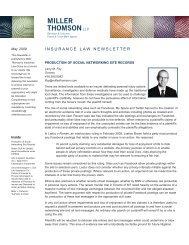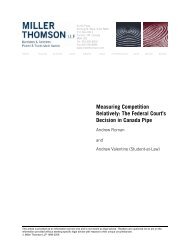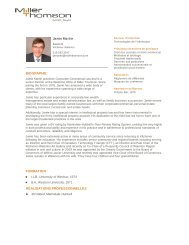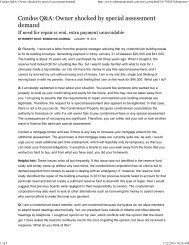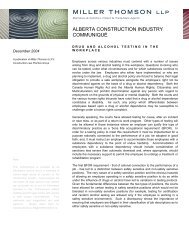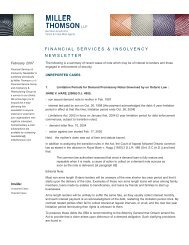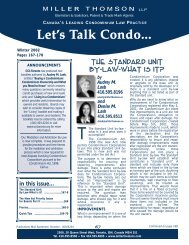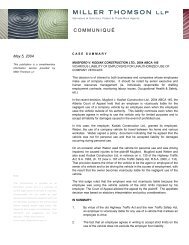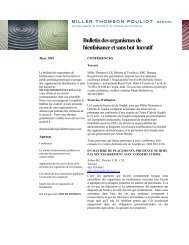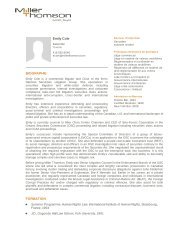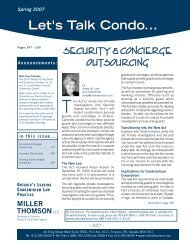"Consent and the Personal Health information ... - Miller Thomson
"Consent and the Personal Health information ... - Miller Thomson
"Consent and the Personal Health information ... - Miller Thomson
Create successful ePaper yourself
Turn your PDF publications into a flip-book with our unique Google optimized e-Paper software.
–22 –<br />
where a person’s consent has not been obtained if <strong>the</strong> <strong>information</strong> comes from, in <strong>the</strong> case of <strong>the</strong><br />
health care sector, a HIC or someone acting on behalf of <strong>the</strong> HIC.<br />
Under PHIPA, a HIC may disclose PHI if <strong>the</strong> HIC believes on reasonable grounds that <strong>the</strong><br />
disclosure is necessary to eliminate or reduce a “significant risk of serious bodily harm to a<br />
person or group of persons… Such circumstances would even override an individual’s prior<br />
express instructions not to disclose <strong>the</strong> relevant personal health <strong>information</strong>.” 109 For example, if a<br />
health care practitioner’s client was at risk of committing suicide, <strong>the</strong> health care practitioner<br />
could disclose <strong>the</strong> client’s PHI to that client’s family or physician if <strong>the</strong>re were reasonable<br />
grounds to believe that such disclosure was necessary to reduce <strong>the</strong> risk of suicide. 110<br />
The disclosure of harm provision under PHIPA can also be read in conjunction with <strong>the</strong> common<br />
law duty to warn <strong>and</strong> health professional obligations. For example, <strong>the</strong> College of Physicians<br />
<strong>and</strong> Surgeons recognizes a duty to inform or a duty to warn. For example, where a physician has<br />
reason to believe that a patient will carry out threats of violence against a specific person or<br />
group of persons, <strong>the</strong> physician should report details of <strong>the</strong> threat to police or in some instances,<br />
<strong>the</strong> intended victim. Reports generally include <strong>the</strong> threat, <strong>the</strong> situation, <strong>the</strong> clinician’s opinion<br />
<strong>and</strong> <strong>the</strong> <strong>information</strong> upon which <strong>the</strong> opinion is based. 111<br />
The Supreme Court of Canada 112 has also provided some useful guidelines in terms of when a<br />
duty to warn may be triggered, recognizing that this will involve a professional judgment on <strong>the</strong><br />
part of <strong>the</strong> clinician:<br />
1. Identifiable: <strong>the</strong>re is a clear risk to an identifiable person or group of persons<br />
2. Seriousness: <strong>the</strong>re is a risk of serious bodily harm or death; <strong>and</strong><br />
3. Imminence: <strong>the</strong> danger is imminent.<br />
M<strong>and</strong>atory Disclosure<br />
The above scenarios sketch out <strong>the</strong> circumstances when disclosure is permissible. There are also<br />
a number of situations where a HIC has a legal obligation to disclose PHI to specified entities.<br />
Examples include <strong>the</strong> reporting of:<br />
<br />
<br />
<br />
suspected child abuse or neglect under <strong>the</strong> Child <strong>and</strong> Family Services Act to a<br />
Children’s Aid Society;<br />
health conditions that make it dangerous for an individual to drive to <strong>the</strong> Ministry<br />
of Transportation;<br />
certain deaths to <strong>the</strong> Coroner;<br />
109 Ibid. at 2<br />
110 Ibid., See also PHIPA, s. 40(1)<br />
111<br />
The College of Physicians <strong>and</strong> Surgeons of Ontario, M<strong>and</strong>atory Reporting Policy #3-05, published<br />
January/February 2006<br />
112 Smith v. Jones, [1999] S.C.J. No. 15 (S.C.C.)




